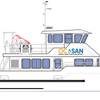The break up and sinking of 25-year-old Erika during mid-December 1999 at first seemed nothing more than another tragic marine mishap. However, Erika has taken on a posthumous life that threatens to shake the maritime industry from the roots up. While the case is still unfolding and much of the coverage contains more than its fair share of political rhetoric and saber rattling, it is fair to say that the name Erika could easily take on the same significance as Valdez in the coming years. It is appropriate, at this point, to state that the word “alleged” cannot be employed enough in this article. At press time, while strong evidence was mounting, nothing had been definitively proven.
Despite all of the “he said, she said” back and forth currently running between the French Government, Italian classification society RINA, French oil major (and Erika charterer) TotalFina, flag of convenience states and the various organizations entrusted with ensuring that tankers which sail the seas are worthy of carrying cargo, the controversy really boils down to a handful of points: Old Ships; Proper Maintenance; and Reliable Inspection Information.
The suspected culprit in the sinking of Erika is a corroded bulkhead, a weakness in the ship structure, which was was not discovered despite the ship being put through several inspections over the past three years. TotalFina, the French oil major which chartered Erika, is being accused of using lax requirements in employing the ship, a cry which grew exponentially when it was uncovered that Royal Dutch Shell had refused to charter Erika for the last two years. The accident has French officials fuming, calling for a number of new measures, including improved national and international safety regulations in regards to tankers, and end to flags of convenience. Shipowners have joined the fray as well. Notably, Lars Carlsson, president of Concordia Maritime, was quoted as saying that shipowners could face “unpredictable and inefficient” legislation if they did not act to improve safety themselves.
If there is a silver lining, it encircles the world’s “quality” owners and operators. Predictably, much of the early rumblings have centered on the ship’s age, and some knee-jerk reaction has centered on unilaterally condemning ships over a given age. BP Amoco, for example, while not condemning older ships, has judiciously announced plans to tighten its rules in regard to the employment of tankers older than 20 and 25 years. But as has been proven time and again — while the age of a ship cannot be entirely dismissed — a properly maintained ship of any age is critical to the safe and successful transport of people and products. Thus shipowners who have traditionally employed a program of excellent ship repair and maintenance should prosper in the renewed era of heightened sensitivity; and shipyards should prosper as commitments to ship maintenance rise, either voluntarily or by legislative mandate.
Subscribe for
Maritime Reporter E-News
Maritime Reporter E-News is the maritime industry's largest circulation and most authoritative ENews Service, delivered to your Email five times per week









